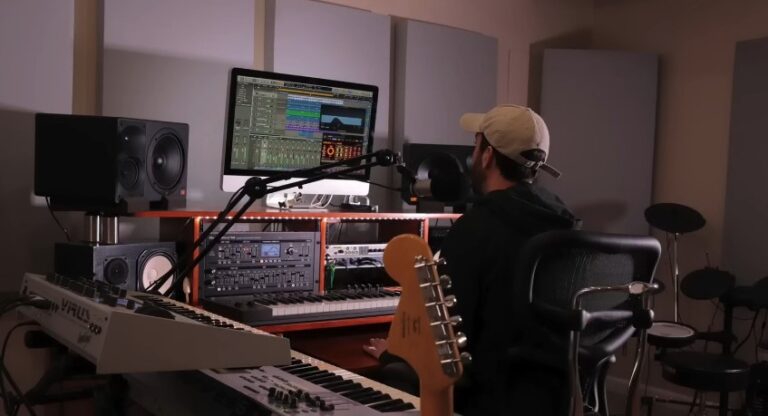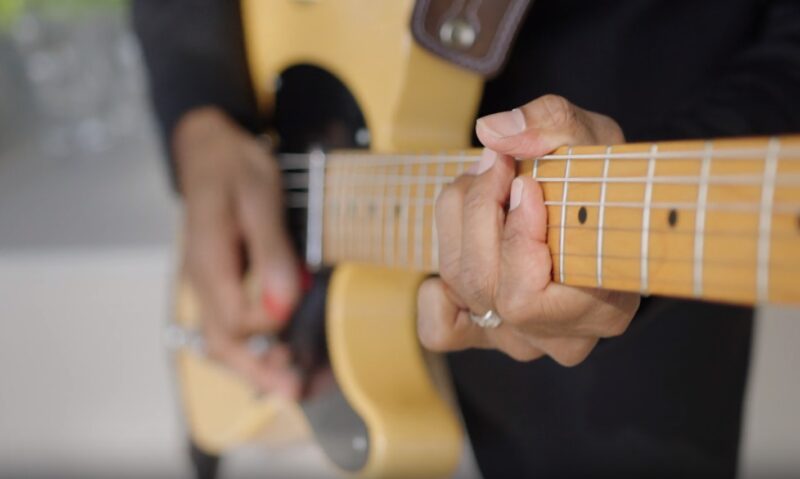In the vast expanse of musical expression, the guitar has stood out as an instrument capable of conveying a wide range of emotions and technical prowess. Among the countless guitar pieces that have graced our ears over the years, a select few stand out as monumental achievements in instrumental music.
These guitar songs, transcending genres and eras, have not only showcased the extraordinary skills of their creators but have also left an indelible mark on the landscape of music. In this exploration, we delve into ten of the greatest instrumental guitar songs of all time, each a masterpiece in its own right.
Table of Contents
Toggle10. “Far Beyond the Sun” – Yngwie Malmsteen
Yngwie Malmsteen, a Swedish virtuoso, brought a revolutionary approach to guitar playing, combining the intensity of heavy metal with the complexity of classical music. His track “Far Beyond the Sun” is a testament to his unparalleled skill and speed.
The song, featured on his 1984 album ‘Rising Force,’ is a whirlwind of arpeggios, lightning-fast scales, and neo-classical flourishes. Malmsteen’s playing is not just about speed; it’s about the precision and clarity with which he executes each note, creating a sound that is both ferocious and articulate. This song has inspired a generation of guitarists to explore the boundaries of their instrument, blending technical proficiency with musicality.
9. “El Farol” – Carlos Santana
Carlos Santana’s “El Farol” from his 1999 album “Supernatural” stands as a shining example of his unique fusion of Latin rhythms, bluesy guitar licks, and soulful melodies. Santana’s guitar tone is distinctive – slightly gainy yet clean, rich in sustain and warmth.
In “El Farol,” he weaves a tapestry of sound that is both rhythmically compelling and melodically enchanting. His ability to blend these elements into a cohesive whole is a hallmark of his style, making this song a standout piece in his extensive catalog.
8. “Albatross” – Fleetwood Mac
“Albatross,” composed by Peter Green, is a blues-rock instrumental that showcases a different facet of Fleetwood Mac’s musical identity. This track, from the band’s early era, is a soothing, oceanic soundscape that stands in contrast to their later, more mainstream hits.
The song’s languid tempo and reverb-drenched guitar lines create a dreamy atmosphere that has been influential in genres as diverse as ambient and rock music. “Albatross” is not just a song; it’s an auditory journey that demonstrates the evocative power of the guitar.
7. “Bron-Yr-Aur” – Led Zeppelin
Jimmy Page, known for his electrifying riffs and solos with Led Zeppelin, showcased a different side of his musical persona with “Bron-Yr-Aur.” This acoustic instrumental, named after a cottage in Wales where Page and Robert Plant wrote much of Led Zeppelin III, is a gentle, folky piece that reflects the pastoral beauty of its namesake.
Played in open C tuning, the song is a testament to Page’s versatility, seamlessly transitioning from hard-rocking electric guitar work to delicate, fingerpicked acoustic melodies.
6. “Cause We’ve Ended As Lovers” – Jeff Beck
Jeff Beck, a guitarist known for his expressive playing and innovative techniques, delivered a masterpiece with “Cause We’ve Ended As Lovers.” Featured on his 1975 album ‘Blow by Blow,’ this song is a journey through various emotional landscapes, starting with slow, soulful bends and gradually building into more complex, blues-infused passages.
Beck’s touch is sensitive and dynamic, making his guitar sing with a voice-like quality. This track is a prime example of how instrumental music can convey profound emotions without words.
5. “Nocturne” – Julian Lage
Julian Lage, a modern master of jazz guitar, brings a fresh perspective to the genre with his rendition of Chopin’s “Nocturne.” Lage’s interpretation is a fusion of classical sensibility and jazz improvisation, showcasing his deep understanding of both styles.
His clean, articulate tone and the seamless integration of melodic lines and chordal accompaniment make this piece a standout in contemporary guitar music. “Nocturne” demonstrates Lage’s ability to bridge genres while maintaining a distinct voice on the guitar.
4. “Ocean” – John Butler
Australian musician John Butler’s “Ocean” is a dynamic, emotionally charged composition that highlights his unique approach to the guitar. Known for his percussive playing style, Butler incorporates techniques like two-handed tapping and harmonics to create a rich tapestry of sound.
“Ocean” is more than just a showcase of technical ability; it’s a deeply personal piece that evolves with each live performance, reflecting Butler’s ongoing artistic journey.
3. “Manhattan” – Eric Johnson
Eric Johnson, a guitarist renowned for his meticulous approach to tone and technique, shines in “Manhattan.” This track, from his 1996 album ‘Venus Isle,’ is a blend of jazz sensibilities and rock energy, characterized by Johnson’s fluid playing and crystal-clear tone.
His ability to craft melodic lines that are both complex and accessible is on full display in this song, making it a favorite among guitar aficionados.
2. “Little Wing” – Stevie Ray Vaughan & Double Trouble
Stevie Ray Vaughan’s interpretation of “Little Wing,” originally written by Jimi Hendrix, is a powerful tribute to one of his biggest influences. Vaughan’s version, featured on the album ‘The Sky Is Crying,’ won a Grammy for Best Rock Instrumental Performance.
His rendition is a masterclass in blues guitar, combining technical prowess with deep emotional expression. Vaughan’s intense, soulful playing breathes new life into this classic, showcasing his unique Texas blues style.
1. “Before The Beginning” – John Frusciante
John Frusciante, best known for his work with the Red Hot Chili Peppers, demonstrates his more introspective and melodic side with “Before The Beginning.” This slow-paced instrumental, from his 2009 album ‘The Empyrean,’ is rich in emotion, featuring soulful bends, slides, and a distinctive picking style.
Frusciante’s approach to the guitar is less about technical flash and more about creating a mood, a feeling. This song is a prime example of how he uses the instrument to convey a deep sense of introspection and melancholy.
If you are interested in reading about the most complex guitar songs ever, visit here.
FAQs
How has the evolution of guitar technology influenced these instrumental songs?
The evolution of guitar technology, including electric amplification, effects pedals, and advances in guitar crafting, has greatly influenced these songs. It allowed artists to explore a wider range of sounds and techniques, from the distorted solos of Malmsteen to the crystal-clear tones of Eric Johnson, creating more dynamic and expressive musical pieces.
What impact have these instrumental guitar songs had on non-guitarist musicians?
These instrumental guitar songs have had a significant impact on non-guitarist musicians by inspiring innovative approaches to composition and performance in other instruments. The technical skill and emotional depth showcased in these tracks encourage musicians of all types to push the boundaries of their craft.
Are there any notable contemporary guitarists who have been directly influenced by these tracks?
Yes, many contemporary guitarists cite these tracks as major influences. For example, guitarists like Joe Satriani, John Mayer, and Tosin Abasi have spoken about the inspiration they’ve drawn from these masterpieces, incorporating elements into their own unique styles.
How do these guitar songs incorporate musical elements from other cultures?
Several of these songs incorporate musical elements from various cultures. For instance, Carlos Santana’s “El Farol” infuses Latin rhythms and scales, while John Butler’s “Ocean” has traces of Australian aboriginal music influences, showcasing the guitar’s versatility in bridging cultural sounds.
What role has music technology, like looping and layering, played in these compositions?
Music technology, such as looping and layering, has played a significant role in some of these compositions. They allow artists to create more complex soundscapes and textures, enhancing the depth and richness of the music. For example, live performances of John Butler’s “Ocean” often feature looping techniques to build up its intricate layers.
Have any of these guitar pieces been used in notable film or television soundtracks?
Yes, some of these guitar pieces have been featured in film and television soundtracks, adding emotional depth and atmosphere to various scenes. For example, “Albatross” by Fleetwood Mac has been used in several films and TV shows, often to evoke a sense of calm and introspection.
Final Words
Each of these instrumental guitar songs, while vastly different in style and approach, shares a common thread – the ability to communicate profound emotions and ideas through the six strings of a guitar. They stand as landmarks in the history of music, not only for their technical brilliance but also for their emotional depth and artistic integrity.
From the rapid-fire arpeggios of Malmsteen to the soulful bends of Beck, these songs represent the pinnacle of what can be achieved with a guitar. They continue to inspire and influence musicians across the world, reminding us of the power and versatility of this remarkable instrument.
Related Posts:
- Why Michael Jackson's "Thriller" Continues to Be the…
- Arizona Cardinals Greatest Players and Their Legacy…
- All the Music Videos Where Mike Tyson Stole the Show
- Snoop Dogg’s Luxurious Lifestyle - What Does the Rap…
- Top 10 Most Complex Guitar Songs Ever Recorded
- 42 Most Famous Songs in A Minor Key - A Comprehensive List








